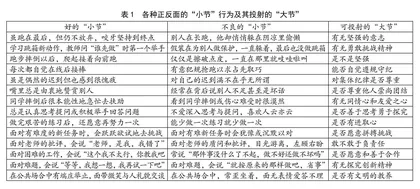论体育立德树人和体育课程思政的策略与方法(二):目标、内容与方法
作者: 毛振明 梁凤波 温君慧

摘 要:针对体育立德树人和课程思政的困局与问题,就目标、内容与方法进行讨论。首先讨论如何理解体育立德树人的核心功能,构建更加科学的目标等有关问题,提出要解决体育立德树人目标设定中“追全”“求大”“浮表”和“轻行”等问题。随后讨论如何建构体育立德树人和课程思政的内容体系和教材问题,以全国学校体育联盟(教学改革)德育团队编写的《体育弟子规》内容和《体育品行课课养》教材为例,对建构体育德育教材的基本原则进行了讨论。进而对体育立德树人和课程思政的方法论如体育立德树人的机理、创设情景、教程步骤等进行了讨论,还以北京师范大学公共体育游泳课的教学为例,对培养学生意志的教学过程、教材准备以及实践效果进行介绍。最后,提出对大、中、小学体育立德树人和课程思政的8点建议,即厘清学生思想品行突出问题、勾画学生身心健康“理想像”、摈弃极端以学生为中心思想、构建体育课程思政内容体系、探索体育思政有效途径方法、加强体育树人的家校社共育、创编《体育课程思政教材教法》、研究体育师德内容与评价标准等。
关 键 词:体育立德树人;体育课程思政;教材体系;体育弟子规;体育家校共育
中图分类号:G807 文献标志码:A 文章编号:1006-7116(2023)04-0001-10
The practicable strategies and approaches of moral establishment and student cultivation through physical education and ideological and political education on physical education curriculum (2):Goal,content and method
MAO Zhenming1,LIANG Fengbo2,WEN Junhui3
(1.School of Physical Education,Zhengzhou University,Zhengzhou 450001,China;
2.Department of Physical Education,Beijing Jiaotong University,Beijing 100044,China;
3.Department of Students’ Work,Beijing College of Finance and Commerce,Beijing 101101,China)
Abstract: In view of the dilemma and problems of moral establishment and student cultivation through physical education and ideological and political education on physical education curriculum, this paper continues to discuss the problems of goal, content and method. At first, this work discusses related problems about how to understand the core function of moral establishment and student cultivation through physical education to construct more scientific goals, and then suggests to solve the problems of pursuing the whole, seeking the big, floating table and light line in the goal setting of moral establishment and student cultivation through physical education. Then, this study also discusses how to construct the problem of content system and teaching materials of moral establishment and student cultivation through physical education and political education on physical education curriculum, and the basic principles of constructing teaching materials for moral education of physical education are discussed by taking the teaching materials of Sports Disciples' Regulations and Sports Moral Education compiled by the moral education team of the National School Sports Alliance (teaching reform) as examples. Furthermore, this paper discusses the methodology of moral establishment and student cultivation through physical education and ideological and political education on physical education curriculum, including mechanism, the creation of scenarios, and tutorial steps from moral establishment and student cultivation through physical education. This paper also takes the teaching of swimming class from public physical education at Beijing Normal University as an example to introduce the teaching process, the preparation of teaching materials, and the practical effect about cultivating students' willingness. Finally, this paper puts forward eight suggestions on moral establishment and student cultivation through physical education and ideological and political education on physical education curriculum aiming to physical education in colleges and universities, junior and senior high schools, and elementary schools in China, such as clarifying the emergent problems of students' ideological and moral character, outlining the ideal image of students with positive physical and mental health, abandoning the extreme student-centered idea, constructing the content system of ideological and political education on physical education curriculum, exploring the effective ways and means of ideological and political education on physical education curriculum, strengthening the co-education from family, school and society of cultivating people by physical education, compiling the teaching materials and methods of ideological and political education on physical education curriculum, and also studying the content and evaluation criteria of teachers' morality from physical education.
Keywords: moral establishment and student cultivation through physical education;ideological and political education on physical education curriculum;teaching material system;rules of physical education disciples;co-education in physical education from home and school
体育立德树人和课程思政的效果欠佳,除受应试教育、不良社会风气和有欠缺的家庭教育外在影响外,其自身理论和实践的不足也是内在的重要原因,体现在目标论方面,存在着盲目追求体育的多功能和多目标,导致德育目标的“虚化”及上下位目标的“虚实错位”;在内容论方面,存在着对德育内容的“浅读浅解”,导致体育德育教材的“平庸化”和“碎片化”;在方法论方面,存在着对德育教育教学方法研究的严重缺失,存在着“自然成就”的错误认识与做法。另外,在体育立德树人的环境论方面,存在着教育“温情化”“规矩制度缺位”“教师身教不足”以及“家、校、社体育共育不足和责任分散”等问题[1]。在此,本研究针对这些问题就目标、内容与方法进行讨论。
1 深刻理解体育立德树人的核心功能,构建科学的目标理论
体育立德树人和课程思政在目标设定方面的问题主要体现在“追全”“求大”“浮表”和“轻行”4个方面,究其根源均因对体育功能及功能与目标的关系理解不够深刻所致[2]。
1.1 纠正“追全”倾向,努力实现体育立德树人和课程思政的核心目标
所谓“追全”,是指将体育德育的功能说得满满的,将体育课程思政的可行性说得多多的,这种错误倾向在2001年版的《体育与健康课程标准》表现得尤为突出,其中列出100个体育品行的目标难以指导基层体育教师去切实地贯彻执行[3]。“追全”极易导致体育立德树人和体育课程思政迷失重点目标,形成“眉毛胡子一把抓”和“丢西瓜捡芝麻”现象。克服“追全”的正确做法是以青少年的主要品行问题与发展为导向,抓紧主要矛盾和主要矛盾方向进行教育,大力加强体育立德树人和课程思政的针对性。
何为青少年品德教育的主要目标?这在领袖和伟人的论述中可清晰循迹:毛泽东[4]在《体育之研究》中说:体育强筋骨,进而增知识、调感情、强意志;习近平[5]在全国教育大会上指示:要树立健康第一的教育理念,开齐开足体育课,帮助学生在体育锻炼中享受乐趣、增强体质、健全人格、锤炼意志;蔡元培说:完全人格、首在体育[6]。从上述领袖和伟人论述中可以看出,体育立德树人之主要方向为:(1)体育调节感情,能培养人朝气蓬勃积极向上的乐观精神,此是体育不同于其他文化活动具有最显著效果的精神陶冶;(2)体育锤炼意志,能培养人不怕苦累崇尚坚持的奋斗的精神,这是体育明显不同于其他文化活动具有显著效果的身心锤炼;(3)体育健全人格促进社会化,能培养人与人和睦相处、遵规守矩的团队协作精神,体育相较于其他文化活动有显著集体教育的效果。
依据领袖和伟人的指引,让学生享受运动乐趣,培养其乐观向上之精神,帮助学生健全人格,培养其集体精神促进社会化,锤炼学生的意志,使其成为不惧挫折勇于进取的接班人,应是新时代立德树人和课程思政的核心目标。
1.2 纠正“求大”倾向,将体育立德树人目标落在细节与实处
所谓“求大”,是将体育立德树人和课程思政的目标制定过高,这种错误主要体现在具体的教育教学计划中。体育立德树人和课程因涉及意识形态、精神、人格和“三观”层面,其上位目标有“高大上”也属正常,但当中观和微观的教育场景中,制定过于“高大上”的目标,必然导致目标内容泛化、方向不清,教育教学望文生义、照本宣科、导致体育立德树人和课程思政教育实效性不佳[7]。要纠正目标“求大”的错误,应注意以下两点:
1)认识到体育立德树人和课程思政目标的多层级性。同其他目标一样,体育立德树人和课程思政也有超学段(课程)、学段(水平)、学年、学期、单元和课时目标等层级。各层级的德育目标有其特定的功能和作用。不分清层级目标的功能特性,层次会被混淆。制订层级目标有其“着眼点”和特定工作,其“搭载文件”也不相同[2]。如《体育与健康课程标准》中不可能出现“课时的德育目标”,同理,教案里也不能出现像“课程德育目标”那样宏观的目标。
2)体育立德树人和课程思政要“从小见大”“抓小促大”。虽然德育里大是大非的问题多,但大是大非的教育却往往是从小事小节抓起。为此,体育立德树人和课程思政切勿“抓大放小”,更不能放任“小节”,相反德育教育要严抓狠抓学生品行的“细枝末节”,将其作为品行教育的突破口和契机,从“小节”里发现学生“大节”的问题,抓好“小节”促其向“大节”的质变转化(见表1)。
1.3 纠正“浮表”倾向,把握体育品行本质实现真目标
所谓“浮表”,是不求甚解、表浅地去理解德育的内涵并将目标设定在表浅的理解之上。道德品行之事即内涵高远又体现在日常,这使得人们往往容易从日常理解去解释道德,形成对品德的“浅读浅解”[8]。在体育实践中,许多体育教师更有将“长跑=意志锻炼”“跳箱=锻炼勇敢”“集体做游戏=团结友爱”“分组比赛=竞争拼搏”“探究讨论=培养创造性”的简单联结。但当大家细究起何为意志、勇敢、坚强、忍耐、公平、组织性纪律性、团结、友爱、顽强、拼搏等时,又觉得说不清道不明。进一步谈及固执与意志、莽撞与勇敢、懦弱与忍耐、平均与公平、哥们义气与团结、取巧与竞争的区别时,迷茫的人更多。因此,要克服“浮表”的错误,必须要对“良好的道德品行”有正确深刻的理解。
道德品行的结构要素:(1)在何种环境下面对何种困难,此时良好的道德品行和不良道德品行的面对是一样的;(2)应对的态度(即思想意识),此时良好道德品行和不良道德品行的面对是不一样的;例如“勇敢”思想意识是正确而理性的,是“为正义和他人利益的勇为”,莽撞则是不正确和不理性的,是“抱有侥幸心理的情绪化的勇为”,而懦弱则是不正确但理性的“为私利的不勇为”;(3)应对表现(行为),此时良好的道德品行和不良道德品行的表现有时相同有时不同,如勇敢和莽撞仅从行为上看都是勇为,而懦弱和谨慎都是慎行;(4)态度和行为是否成为习惯性反应,习惯性的就是稳定的道德品行,不稳定的就是偶发的行为。依据上述结构要素对主要体育道德品行进行了分析(见表2)。